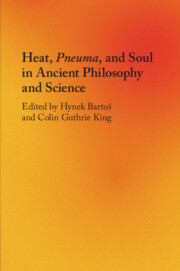Book contents
- Heat, Pneuma, and Soul in Ancient Philosophy and Science
- Heat, Pneuma, and Soul in Ancient Philosophy and Science
- Copyright page
- Contents
- Contributors
- Preface
- Introduction
- I Early Greek Philosophy and Medicine
- II Aristotle
- Chapter 7 Heat, Meteorology, and Spontaneous Generation
- Chapter 8 Aristotle on the Nature in the Pneuma and the First Body
- Chapter 9 Aristotle on the Powers of Thermic Equilibrium
- Chapter 10 Why Animals Must Keep Their Cool: Aristotle on the Need for Respiration (and Other Forms of Cooling)
- Chapter 11 Soul’s Tools
- Chapter 12 When Life Imitates Art: Vital Locomotion and Aristotle’s Craft Analogy
- Chapter 13 Blood, Pneuma, or Something More Solid? Aristotle on the Material Structure of Perceptual Apparatus
- Chapter 14 The Pathological Role of Pneuma in Aristotle
- Bibliography
- Index Locorum
- Index
Chapter 9 - Aristotle on the Powers of Thermic Equilibrium
from II - Aristotle
Published online by Cambridge University Press: 20 February 2020
- Heat, Pneuma, and Soul in Ancient Philosophy and Science
- Heat, Pneuma, and Soul in Ancient Philosophy and Science
- Copyright page
- Contents
- Contributors
- Preface
- Introduction
- I Early Greek Philosophy and Medicine
- II Aristotle
- Chapter 7 Heat, Meteorology, and Spontaneous Generation
- Chapter 8 Aristotle on the Nature in the Pneuma and the First Body
- Chapter 9 Aristotle on the Powers of Thermic Equilibrium
- Chapter 10 Why Animals Must Keep Their Cool: Aristotle on the Need for Respiration (and Other Forms of Cooling)
- Chapter 11 Soul’s Tools
- Chapter 12 When Life Imitates Art: Vital Locomotion and Aristotle’s Craft Analogy
- Chapter 13 Blood, Pneuma, or Something More Solid? Aristotle on the Material Structure of Perceptual Apparatus
- Chapter 14 The Pathological Role of Pneuma in Aristotle
- Bibliography
- Index Locorum
- Index
Summary
Popa focuses on the role of the two basic active dunameis, the hot and the cold, in Aristotle, Meteorology IV. There, the dispositional properties of the homoeomers are often defined and explained in virtue of bodies’ reactions to heat and cold: some homogeneous bodies are solidifiable by heat, others by cold. Popa argues that Meteor. IV aims to account for the coming about and persistence of uniform stuffs by appealing to what he calls “thermic equilibrium” (summetria, logos). The main purpose of this chapter is to clarify the ways in which Aristotle puts this notion to work in his study of homogeneous materials (especially in Meteor. IV) and, through this clarification, to contribute to a better understanding of the role played by proper or internal natural heat in his scientific works.
- Type
- Chapter
- Information
- Heat, Pneuma, and Soul in Ancient Philosophy and Science , pp. 202 - 216Publisher: Cambridge University PressPrint publication year: 2020

